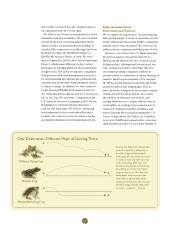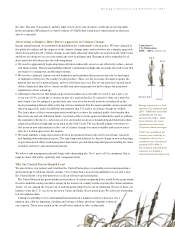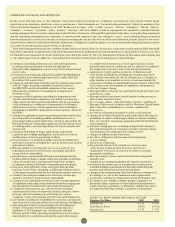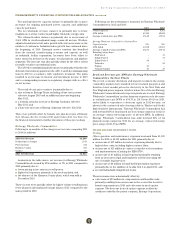Entergy 2011 Annual Report Download - page 29
Download and view the complete annual report
Please find page 29 of the 2011 Entergy annual report below. You can navigate through the pages in the report by either clicking on the pages listed below, or by using the keyword search tool below to find specific information within the annual report.
the rule. The stay was granted, and the legal review and court decision could take several months.
In the meantime, EPA issued a revised version of CSAPR that eases some restrictions but that may
also be contested.
Advocating a Simpler, More Direct Approach to Climate Change
In past annual reports, we presented our guidelines for a sustainable carbon policy. We have adapted to
the political realities and the urgency of the climate change issue, and now advocate a simpler approach
as the best path forward. Climate change is adversely affecting vulnerable areas such as the Gulf Coast
and there are steps we as a society must take now to mitigate this. Entergy is advocating that local,
state and federal leaders take the following steps:
n We need to aggressively begin adaptation efforts in vulnerable areas to cost effectively reduce current
and future losses. That means building resilient communities in high-risk areas like the Gulf Coast that
are subject to rising seas and stronger storms.
n We need to eliminate climate-related subsidies and mandates that promote specific technologies
at multiples of the price the market would produce. There are far too many attempts to game the
system and use it for personal gain, and too often they succeed. The recent national cap-and-trade
debate illustrated this all too clearly as different interest groups worked to shape the proposed
legislation to their advantage.
n Adhering to the theory that simple is good and markets are powerful, we need to put a price on
every ton of CO2 across the economy as part of a national policy. It cannot be done on a state-by-
state basis. One fee rising at a predictable rate over decades would motivate investment in the
most promising solutions while reducing carbon emissions. It is the most equitable and economically
efficient approach, and it would help demonstrate that U.S. policy on climate change is credible.
The lion’s share of the revenues generated would go to reduce the national public debt burden that
threatens our and our children’s future. A portion of the revenue generated should be used to address
the regressive effects of a carbon tax on low- and moderate-income households and fund immediate
adaptation efforts in high-risk areas such as the Gulf Coast. The tax should adjust every three to
five years as new information on the cost of climate change becomes available and as new, more
effective technologies enter the market.
n We must institute a large innovation effort by government that is directed toward basic research
and funding demonstration projects. The only long-term solution to climate change is new technology.
A government-led effort would jump-start innovation, provide financing until private funding becomes
available and serve a great national purpose.
We believe risk management should begin with eliminating the “free” price of CO2 emissions. But it
must be done efficiently, equitably and compassionately.
Why the United States Should Lead
We also believe it is natural and vital that the United States play a leadership role in implementing a
global strategy to address climate change. Our country has a moral responsibility to lead, and it is in
the United States’ clear self-interest to craft an effective global solution.
The United States is the greatest historical producer of carbon emissions in the world. In the generations
it took to build the most powerful economy in the world, our country led the way into the climate situation.
Today, we are among the 10 percent of nations generating 90 percent of emissions. However there are
limits to what the U.S. can do on its own if China and India do not participate. We advocate leadership
but not unilateralism.
Taking a leadership role in addressing this situation is a mission made for America. It’s a
mission that calls for ingenuity, idealism and a sense of duty, which are intrinsic values of
our country. There is no nation in the world better suited to take on this task.
Entergy committed to a third
voluntary CO2 stabilization goal
(2011 – 2020) after successfully
completing two five-year
commitments (2001 – 2010).
Since inception, our actual
cumulative emissions were
12.6 percent below our targets.
In 2011, our greenhouse gas
inventory was verified by an
independent, third party in
accordance with international
standards (ISO 14064.1).
The inventory and verification
statement are available at
www.americancarbonregistry.org.
Cumulative
CO2 Emissions
2001 – 2011, million tons
Voluntary Goal
Actual
521.4
455.5
Entergy Corporation and Subsidiaries 2011
27
























